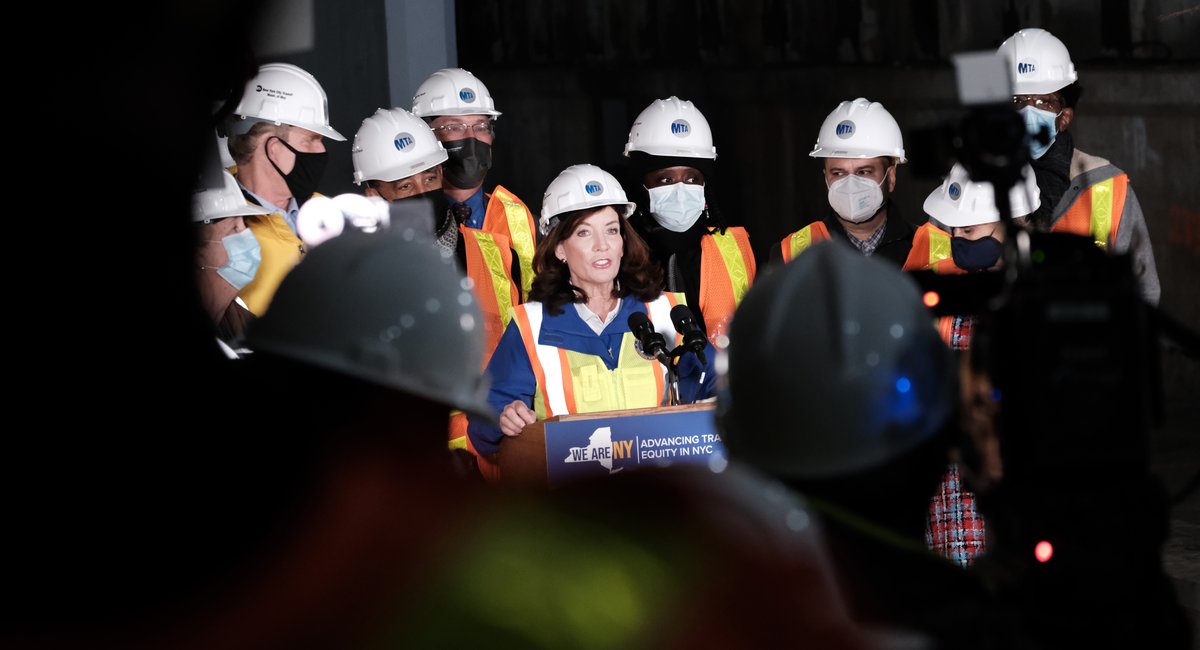The ongoing expansion of the Second Avenue subway may take a westward turn.
Gov. Kathy Hochul is throwing her support behind a new plan to extend the Q train along 125th Street to West Harlem — a measure that calls for building an additional three stations to help bring the line across Manhattan to Broadway, Gothamist has learned.
Hochul will make the announcement as part of her State of the State address Tuesday afternoon, marking the start of a new, expanded vision for the still-nascent Second Avenue train line first opened on the East Side in 2017. If completed, new stations would be built at Lenox Avenue, St. Nicholas Avenue and Broadway.
The westward expansion would be years away and comes with an estimated price tag of $8.1 billion, which includes the cost to buy a new fleet of trains. Hochul’s support comes before construction has even started on a separate, $7.7 billion extension project on the Second Avenue subway that is expected to take eight years to complete.
Hochul is also expected to announce the long-sought Interborough Express — a planned light rail line between Bay Ridge, Brooklyn and Jackson Heights, Queens — is taking the next step forward, with the MTA set to begin the formal engineering process for the project.
“There are too many transit deserts in New York City — communities that have been left out and left behind for far too long,” Hochul said in a statement. “That’s why I’m so committed to the future of the Second Avenue Subway and the Interborough Express, two projects that will transform the way New Yorkers get around our city.”
Hochul is scheduled to deliver her annual address from the ornate Assembly chamber in the state Capitol in Albany.
The Second Avenue subway announcement is expected to headline the portion of her speech dedicated to public transit. The governor, meanwhile, has said she will focus much of her agenda on two major areas: Crime and mental health.
Hochul is also facing questions about her plans to create new housing in New York after her proposal to impose growth mandates on municipalities was rejected by the Legislature last year.
The governor’s support for extending the Second Avenue subway to West Harlem marks a departure from a century-old plan for the line. Since the 1920s, transit planners have proposed building the tracks along Manhattan’s East Side all the way downtown.
But after a century of stops and starts, the Second Avenue subway only has three completed stops on the Upper East Side.
Hochul’s expected announcement comes as the MTA has yet to put shovels in the ground for the second phase of the Second Avenue subway project. The expansion will run 1.5 miles into East Harlem, extending the Q line from its northern terminus at East 96th Street. It will add two new stations at East 106th Street and East 116th Street, as well as a new station below the existing East 125th Street station. When it’s completed, the line will connect to the 4, 5 and 6 trains.
But that project still has several outstanding issues.
While the federal government has agreed to cover $3.4 billion of that cost, the MTA is on the hook for the rest of the estimated $7.7 billion project. The agency is relying on funding from congestion pricing — a toll on drivers entering Manhattan below 60th Street — to cover it. The toll isn’t expected to go into effect until the spring, but could be further delayed by several pending lawsuits.
The second phase of the project will also require the state to use eminent domain to seize certain properties along the project’s route.
The MTA first floated the idea of a westward expansion in October, when it released the results of an analysis that looked at the needs of the New York City public-transit system.
One of the conclusions was that an east-west extension — which would connect the Q to seven other train lines — would be more cost effective and useful than a downtown extension. By 2045, the MTA estimates the West Harlem extension would serve an estimated 239,700 daily riders and save them an estimated 3.8 minutes per trip.
At the time, Jamie Torres-Springer, president of MTA Construction & Development, said it was too soon to say whether the MTA would throw its weight behind the idea.
“It would be moving to the west of the existing project and there’s some interesting synergies there, but it’s too early to say that we’d be able to invest in it,” he said. “We’re merely pointing out that we’ve done this evaluation and people will judge for themselves.”
According to Hochul’s office, the MTA will immediately launch what’s known as a “feasibility study” to determine whether the western expansion is even possible. That study will also look at whether it would be possible to do some of the tunnel boring during Phase 2 construction, a move the governor’s office estimates could save up to $400 million.
The study will take an estimated six months to complete, according to Hochul’s office.

Leave a Reply